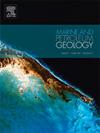因果图岩性分类器:将因果推理与图神经网络相结合,实现高精度测井岩石分类
IF 3.7
2区 地球科学
Q1 GEOSCIENCES, MULTIDISCIPLINARY
引用次数: 0
摘要
岩性分类是地质勘探的一项重要工作,对油气资源的勘探和开发起着至关重要的作用。传统的岩性分类方法往往依赖于经验模型或统计方法。这些方法虽然取得了一定的成功,但在处理复杂的地质数据时,往往会遇到分类精度低、模型泛化差的问题。随着深度学习技术的进步,基于机器学习的岩性分类方法逐渐被采用。然而,这些方法往往忽略了不同岩性之间的因果关系及其对分类结果的影响。本文提出了一种创新的岩性分类方法——因果图岩性分类器(CG-Litho),该方法将图神经网络(GNNs)与因果推理相结合,有效地提高了分类精度和可解释性。最初,地质数据被表示为一个图结构,其中每口井的数据被视为一个节点,井之间的地质相似性或地理关系被表示为边。利用gnn,该模型可以跨节点传播信息,以捕获不同井位之间的空间和地质特征相互关系。为了进一步提高模型的性能,本文引入了因果推理。通过因果干预分析各种地质特征对岩性分类结果的因果影响,避免了传统方法无法解释的相关性问题。这种基于gnn的模型结合了因果推理,不仅识别了岩性之间复杂的相互关系,而且有效地降低了数据噪声对分类结果的影响。实验结果表明,本文提出的因果图岩性分类器在多个实际应用场景中表现优异,与传统的机器学习和深度学习模型相比,分类精度显著提高。特别是在处理复杂地质背景的井资料时,该模型的预测结果更加稳定可靠。此外,该模型的因果干预机制为地质学家提供了更高的可解释性,帮助他们理解变量之间的因果关系,从而优化勘探决策。该研究通过因果图神经网络整合空间信息和因果推理,为岩性分类提供了一种新的方法,使岩性预测更加有效和可解释。该方法不仅在地质勘探中具有广阔的应用前景,而且为其他领域的因果推理和图学习问题提供了有价值的见解。本文章由计算机程序翻译,如有差异,请以英文原文为准。
Causal-Graph Lithology Classifier: Synergizing causal inference with graph neural networks for high-accuracy rock classification in well logging
Lithology classification is a vital task in geological exploration and plays a crucial role in the exploration and development of oil and gas resources. Traditional lithology classification methods often rely on empirical models or statistical approaches. While these methods have achieved some success, they frequently encounter issues such as low classification accuracy and poor model generalization when dealing with complex geological data. With advancements in deep learning technology, machine learning-based lithology classification methods have gradually been adopted. However, these methods often overlook the causal relationships between different lithologies and their impact on classification results. This paper proposes an innovative lithology classification method—the Causal-Graph Lithology Classifier (CG-Litho), which combines Graph Neural Networks (GNNs) and causal inference to effectively enhance classification accuracy and interpretability. Initially, the geological data is represented as a graph structure, where the data from each well is treated as a node, and the geological similarity or geographical relationship between wells is represented as edges. Utilizing GNNs, the model can propagate information across nodes to capture the spatial and geological feature interrelationships between different well locations. To further improve the model's performance, this paper introduces causal inference. By analyzing the causal impact of various geological features on lithology classification results through causal intervention, the model avoids correlation issues that cannot be explained by traditional methods. This GNN-based model, integrated with causal inference, not only identifies the complex interrelationships between lithologies but also effectively reduces the impact of data noise on classification results. Experimental results demonstrate that the proposed Causal-Graph Lithology Classifier excels in multiple practical application scenarios, significantly improving classification accuracy compared to traditional machine learning and deep learning models. Particularly, when handling well data with complex geological backgrounds, the model provides more stable and reliable prediction results. Additionally, the model's causal intervention mechanism offers geologists enhanced interpretability, helping them understand the causal relationships between variables and optimize exploration decisions. This study provides a new approach to lithology classification by integrating spatial information and causal inference through causal graph neural networks, enabling more efficient and interpretable lithology predictions. This method not only holds broad application prospects in geological exploration but also offers valuable insights for causal inference and graph learning problems in other fields.
求助全文
通过发布文献求助,成功后即可免费获取论文全文。
去求助
来源期刊

Marine and Petroleum Geology
地学-地球科学综合
CiteScore
8.80
自引率
14.30%
发文量
475
审稿时长
63 days
期刊介绍:
Marine and Petroleum Geology is the pre-eminent international forum for the exchange of multidisciplinary concepts, interpretations and techniques for all concerned with marine and petroleum geology in industry, government and academia. Rapid bimonthly publication allows early communications of papers or short communications to the geoscience community.
Marine and Petroleum Geology is essential reading for geologists, geophysicists and explorationists in industry, government and academia working in the following areas: marine geology; basin analysis and evaluation; organic geochemistry; reserve/resource estimation; seismic stratigraphy; thermal models of basic evolution; sedimentary geology; continental margins; geophysical interpretation; structural geology/tectonics; formation evaluation techniques; well logging.
 求助内容:
求助内容: 应助结果提醒方式:
应助结果提醒方式:


